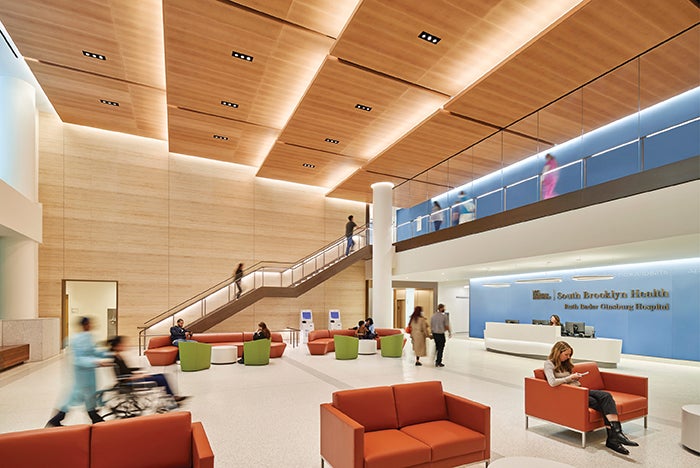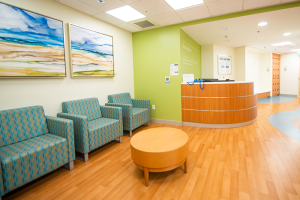New campus designed for hurricane and pandemic readiness

In response to past hurricane activity, the new Ruth Bader Ginsburg Hospital is encircled by a 4-foot-tall perimeter flood wall.
Image by Edward Caruso Photography
Hurricane Sandy devastated New York’s Coney Island Hospital and its campus in 2012, and constructing its replacement faced additional hurdles during the pandemic. Nonetheless, the restored NYC Health + Hospitals South Brooklyn Health campus and the Ruth Bader Ginsburg Hospital, New York City’s first new public hospital in over 40 years, opened last year.
“Growing up, my family used what was then Coney Island Hospital,” says NYC Health + Hospitals President and CEO Mitchell Katz, M.D. “To see it now rebuilt as this amazing place is such a wonderful thing.”
The storm-resilient, 371-bed hospital boasts a flood-proof emergency department, state-of-the-art patient rooms and equipment, and a flood wall designed to withstand a 500-year storm, along with flood-resistant power, heating, cooling and water systems. The new facility also features state-of-the-art operating rooms, improved robotic surgery capabilities, 80 private medical-surgical beds, 60 behavioral health beds, and diagnostic, interventional radiology and clinical laboratories.
The original campus comprised existing buildings, some more than 100 years old, with infrastructure supported by a single central utility plant. John Flanagan, RA, LEED AP, project manager and project architect for global architecture, planning and design firm NBBJ, commented on the risks inherent in that setup.
“Post-Sandy, the electrical connections throughout the campus were fed with industrial temporary cabling,” he says. “Almost like giant extension cords.”
The new perimeter flood wall around the entire campus is approximately 4 feet tall with sliding flood barriers, protecting the existing tower and main buildings. Critical infrastructure was raised from the first floor to the roof level to keep power critical to running the facility safe from flooding.
“All critical services that used to come from the central utility plant now come from the fifth floor of the new Ruth Bader Ginsburg building, where all the information technology services, the main distribution frames and the ‘brains’ of the hospital are now located,” Flanagan says.
The new emergency department is on the second floor, with a ramp accommodating ambulances, police cars and a drop-off area for patients.
“The hospital utilizes a combination of electric elevators, with machine rooms on the highest floor, and hydraulic elevators for express service to the second-floor emergency department. Underground diesel fuel tanks supply the two emergency generators on the fifth floor,” Flanagan explains. “The hydraulic elevator machine rooms, the fuel pumps and any critical infrastructure required on the first floor are located in hardened concrete enclosures 19 feet above flood level.”
Access to each of the hardened spaces is through a gasketed flood-proof door, and every flood control device was subject to in-place testing to ensure they provide the specified level of protection.
The design of the campus also accommodates new realities around COVID-19 and other similar threats, says NBBJ Principal Bryan Langlands, FAIA, FACHA.
“Quickly exploring and making recommendations so that leadership can make informed decisions about what upgrades should be made to make the structure more robust and resilient in the event of another pandemic was an unexpected challenge,” Langlands says.
NBBJ was asked to improve on existing designs based on lessons learned during the pandemic.
“We built the medical-surgical nursing units and patient rooms as flex rooms,” Langlands continues. “We added additional medical gases and electrical power in the patient rooms and increased the overall bulk oxygen capacity to accommodate increased simultaneous ventilator use to treat higher acuity patients if needed. Additionally, we incorporated the ability to convert full nursing unit floors to negative pressure with 100% exhaust to the exterior to address an influx of infectious patients.”
Innovative solutions around resilience are rapidly becoming the norm in health care infrastructure, design and construction.
“One of the most critical aspects of the entire project is the data systems and the backup. There are backups to the backups, which is mind-boggling,” Flanagan says. “I would say these measures are becoming the standard in areas subject to flooding or inundation. In fact, if organizations are not building this way now, they are not building thoughtfully.”




